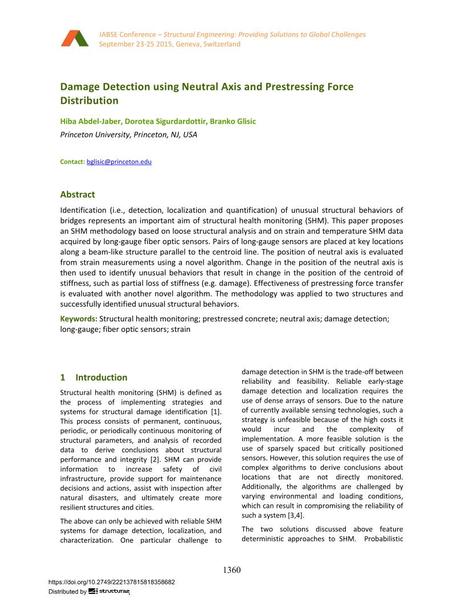Damage Detection using Neutral Axis and Prestressing Force Distribution

|
|
|||||||||||
Détails bibliographiques
| Auteur(s): |
Hiba Abdel-Jaber
(Princeton University, Princeton, NJ, USA)
Dorotea Sigurdardottir (Princeton University, Princeton, NJ, USA) Branko Glisic (Princeton University, Princeton, NJ, USA) |
||||
|---|---|---|---|---|---|
| Médium: | papier de conférence | ||||
| Langue(s): | anglais | ||||
| Conférence: | IABSE Conference: Structural Engineering: Providing Solutions to Global Challenges, Geneva, Switzerland, September 2015 | ||||
| Publié dans: | IABSE Conference Geneva 2015 | ||||
|
|||||
| Page(s): | 1360-1367 | ||||
| Nombre total de pages (du PDF): | 8 | ||||
| Année: | 2015 | ||||
| DOI: | 10.2749/222137815818358682 | ||||
| Abstrait: |
Identification (i.e., detection, localization and quantification) of unusual structural behaviors of bridges represents an important aim of structural health monitoring (SHM). This paper proposes an SHM methodology based on loose structural analysis and on strain and temperature SHM data acquired by long-gauge fiber optic sensors. Pairs of long-gauge sensors are placed at key locations along a beam-like structure parallel to the centroid line. The position of neutral axis is evaluated from strain measurements using a novel algorithm. Change in the position of the neutral axis is then used to identify unusual behaviors that result in change in the position of the centroid of stiffness, such as partial loss of stiffness (e.g. damage). Effectiveness of prestressing force transfer is evaluated with another novel algorithm. The methodology was applied to two structures and successfully identified unusual structural behaviors. |
||||
